There are hundreds of types of ants in Texas. They can be difficult to distinguish as many species look similar. Some ants even look similar to wasps.
One of the easiest methods to distinguish the various ants in Texas is to look at the color, shape, or size of the head, thorax, pedicel (1 or 2 segments connecting the thorax to the abdomen), and abdomen.
Here are the most common species of ants in Texas and their unique characteristics.
Table of Contents
1. Red Imported Fire Ant
Red Imported Fire Ants (Solenopsis invicta) made their way to Texas from South America. The species is considered a pest.
Ants of the species make their way indoors in search of food.
These ants often nest under or on pavements, in the backyard, or next to homes. They are also attracted to electricity and they can damage electrical equipment around the house.

Red Imported Fire Ants can be recognized by brown-red coloring. Male Red Imported Fire Ants are black.
These ants are found in various sizes from 2.4 to 6mm.
The reason for high differences in body size is given by the polymorphic nature of Red Imported Fire Ants.
This means 2 or more variations exist in the same species.
2. Red Harvester Ant
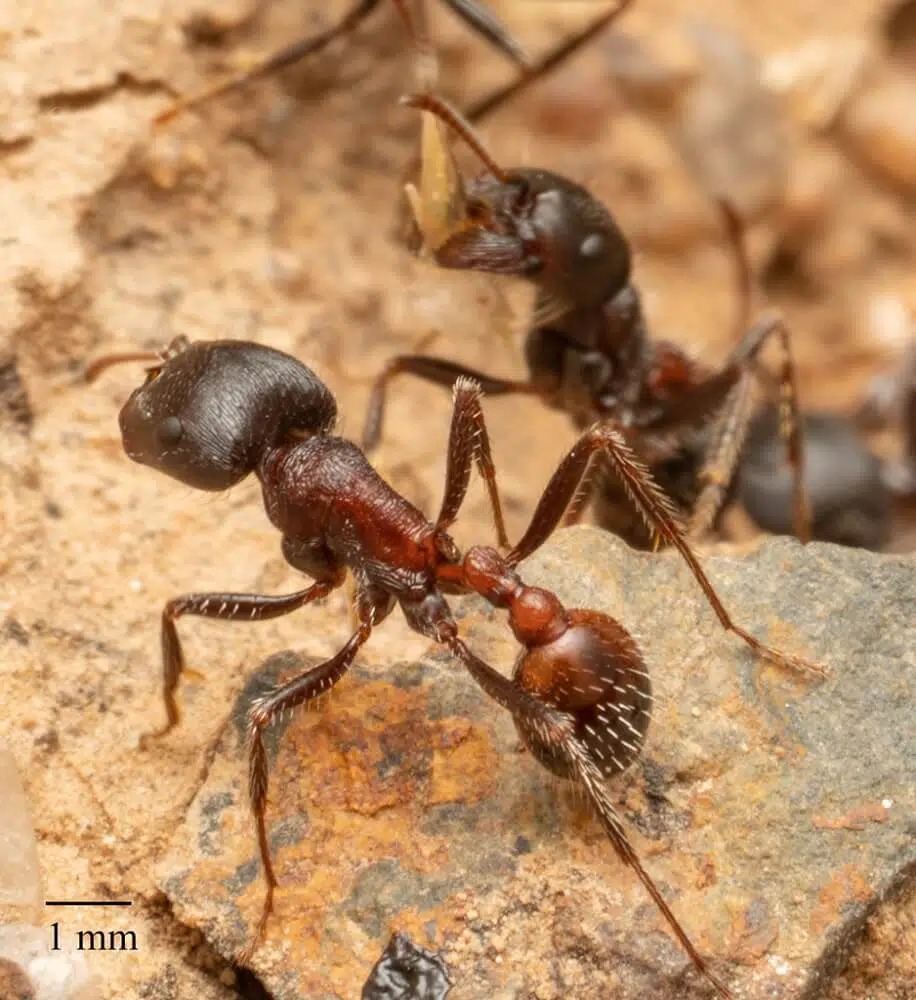
Red Harvester Ants (Pogonomyrmex barbatus) closely resembles Red Imported Ants in color and size. These ants grow to a size between 5 and 7mm.
However, there’s no direct species relation between these ants and Red Imported Ants. Red Harvester Ants are native to the Southwest.
As their name suggests, these ants harvest and store food. They’re mainly interested in creating small granaries where food is stored for consumption throughout the year.
The capacity of the Red Harvester Ant to move seeds from one place to another is considered beneficial both for the ants themselves and for plants.
These ants have also been shown to have extra water from the digested fats in seeds which solely makes them reliable on filaree seeds, buckwheat, and mustant seeds.
3. Texas Leaf-cutter Ant

Also known as the Town ant, the Texas Leaf-cutter (Atta texana) is one of the major pest ants in Texas.
Its negative impact has been noted in over 200 plant species. This ant can defoliate entire trees essentially killing them with a single colony since it has very large colonies.
Texas Leaf-cutter ants have colonies that sometimes number millions of ants. These are often led by several queen ants.
One way to identify the species is by the size of its colony. The physical size of the ants might make identification harder since these ants are polymorphic.
This means they have multiple sizes within the species.
The Texas Leaf-cutter ant can be as little as 4mm or as large as 14mm.
Most of these ants have a rusty-brown color.
4. Eastern Black Carpenter Ant

Eastern Black Carpenter Ants (Camponotus pennsylvanicus) get their name from their Eastern US habitat and black body color.
These ants grow to a size between 14 and 19mm. They aren’t known for stinging but some Eastern Black Carpenter Ants can bite.
Most of these ants are located outdoors in woodlands and gardens where they seek decaying wood to nest.
They can also make their way inside the walls of a home becoming a pest and impacting the structural integrity of a home.
In terms of diet, the species is known as a forager. Ants travel up to 100 yards away from the nest in search of food.
5. Crematogaster laeviuscula
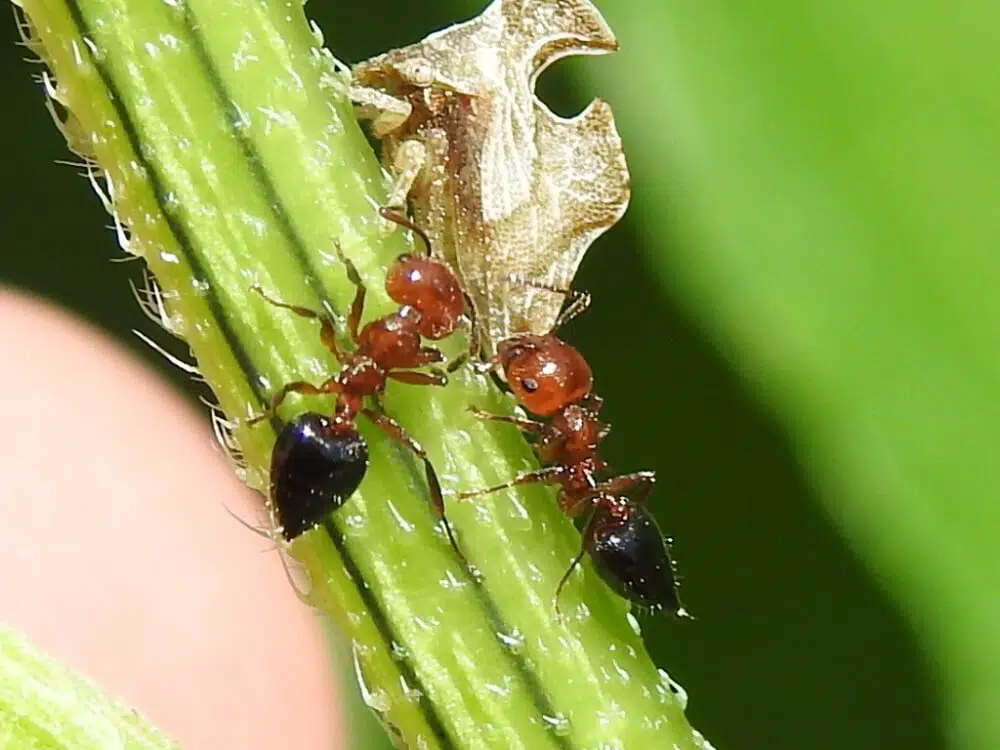
These ants have initially been considered a Western US ant even if they have now been reported on the East coast as well.
The ants are known as acrobats as they can arch the gaster upwards similarly to acrobats.
Having a bi-colored body makes species identification easy. The upper part of the body is orange-red while the abdomen is dark brown to black.
Most of the ants are found in woodlands under leaves or dead logs.
6. Graceful Twig Ant

These winged ant species (Pseudomyrmex gracilis) are commonly found around Texas. Its color can vary from dark brown to black.
Most Graceful Twig Ants live in small nests under the rule of a single queen.
These ants can be seen as home pests, but not to the extent of other ants that nest in wood.
They are mainly found in woodlands in hardwood hummocks and rarely venture indoors.
However, these ants pose a painful sting and should be removed if they manage to make their way indoors.
The species is also common in other regions of the country. However, its coloring can be different depending on its habitat.
7. Dark Rover Ant
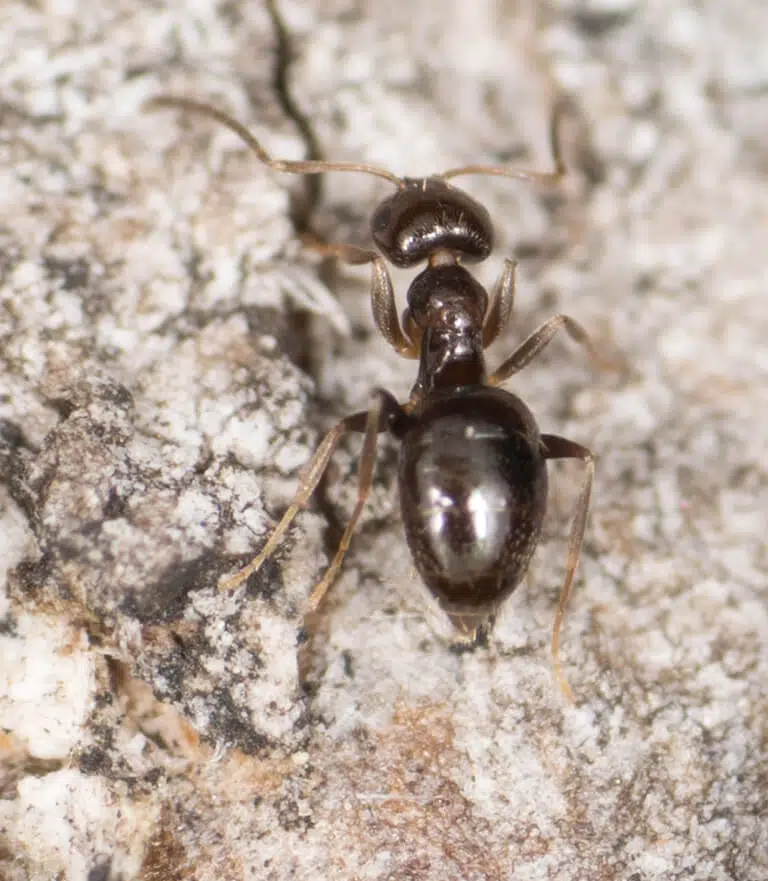
The Dark Rover Ant (Brachymyrmex patagonicus) is one of the fastest-growing species in Texas and other states such as Arizona.
These ants haven’t been thoroughly studied by they are getting more attention as they spread to urban areas.
Mostly found in woodlands where they nest in soils, these small (1 to 3mm) ants are also found around homes, particularly under mulch.
A status of pest is not yet attributed to the Dark Rover Ant to the extent of ants that damage wooden structures of the house.
Even using insecticides is still not recommended to combat eventual Dark Rover Ant colonies that make it indoors.
The easiest way to get rid of these ants is to lure them with honey bait as they eat honeydew and flower nectar.
8. Rough Harvester Ant
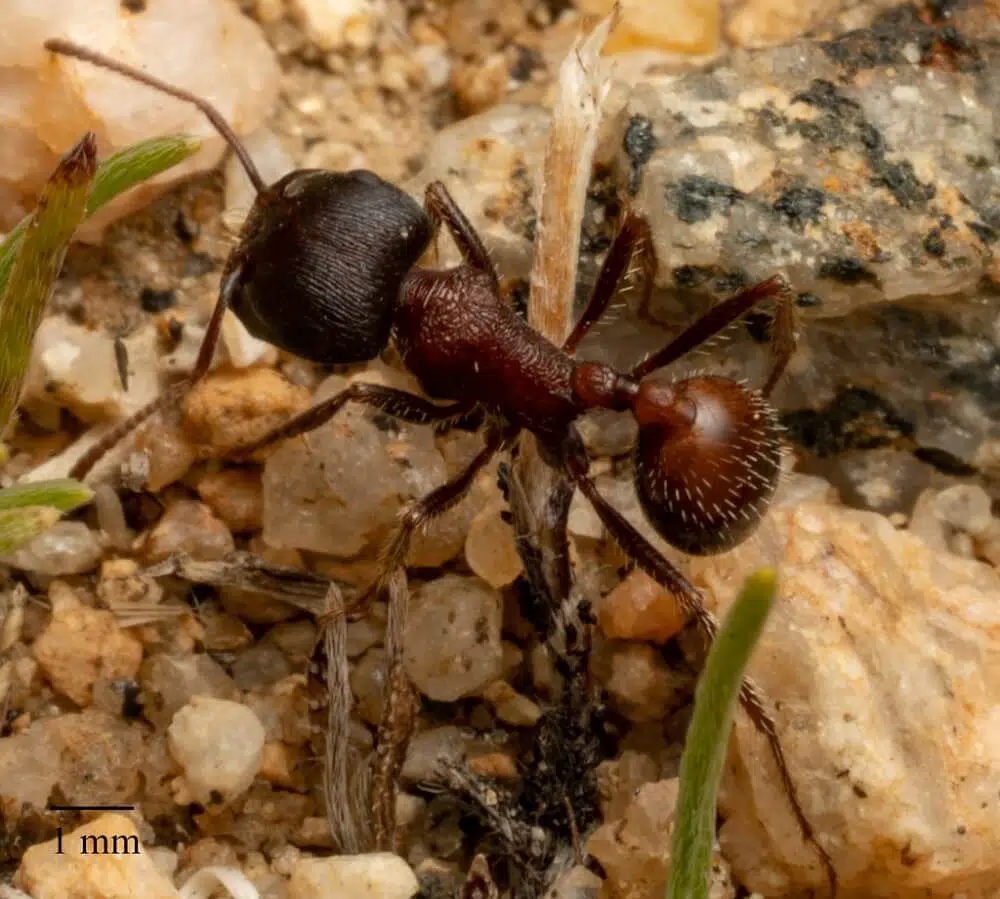
Rough Harvester Ants (Pogonomyrmex rugosus) are known to be endemic to Southern US. These ants are harvesters. They collect seeds.
Erodium cicutarium seeds are preferred by these harvester ants.
Living in colonies of up to 15.000 individuals, these ants use pheromones to create scent trails that lead to these seeds once they discover them.
These ants don’t have a worker cast. They use enslaving techniques instead.
9. Texas Carpenter Ant
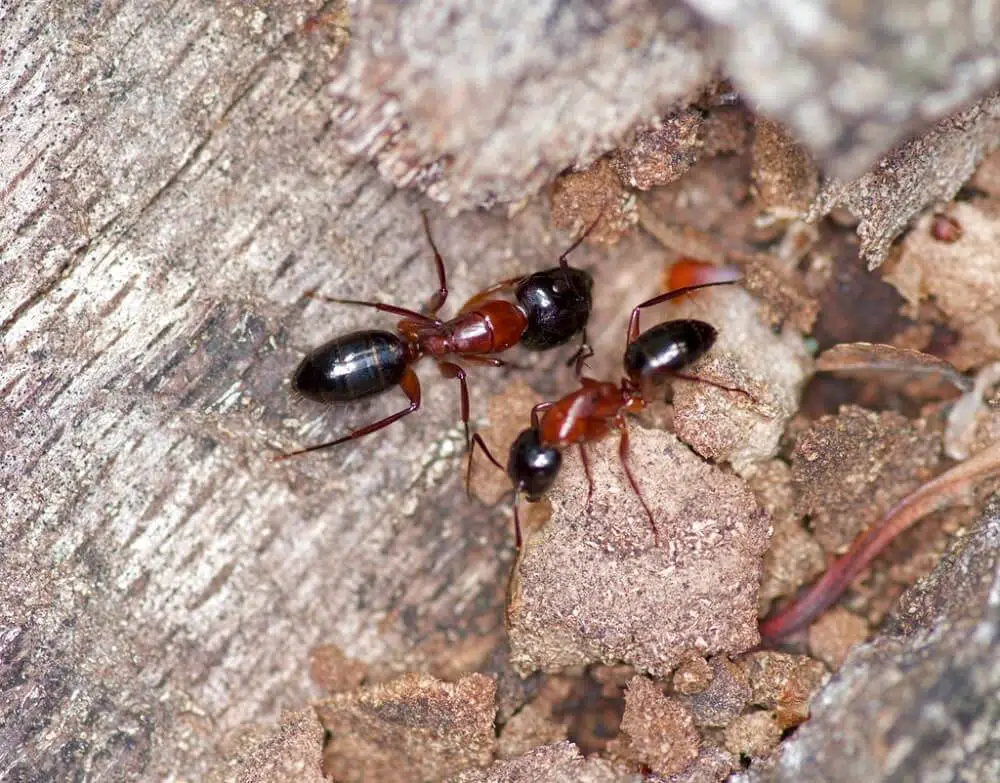
The Texas Carpenter Ant (Camponotus texanus) is endemic to Texas. It’s only found here and it mostly lives around oak and juniper trees in woodlands.
The species is both winged and wingless. Worker casts are identified by a few short hairs on the body while most other casts have a shiny body.
Coloring is red-brown for the thorax while the head and the abdomen are mostly dark brown to shiny black.
Both male and female ants have the same legs coloring which is red-brown, similar to the thorax.
10. Camponotus festinatus
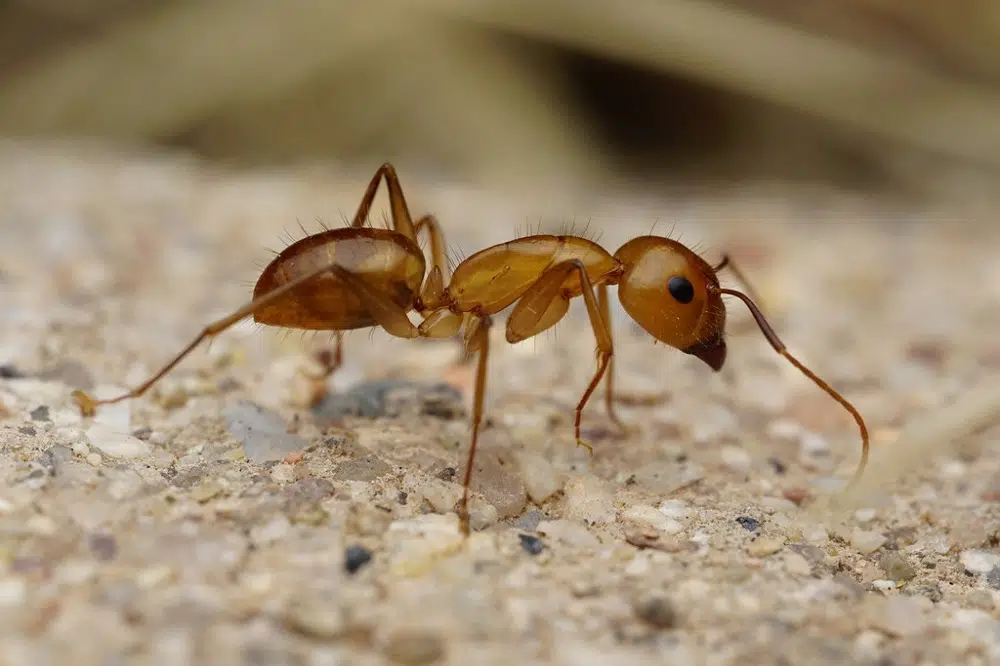
This ant species is native to the Southeastern United States.
As part of the carpenter genus, it’s mostly found in decaying wood and dry parts of Parkinsonia.
The ants of the species are recognized by a light brown color across the body.
Ants of the species are known for only consuming liquid food as they cannot digest solids. They eat tree sap.
These ants are also known for consuming dead animals. They drink the juices of dead insects and animals for higher protein intake.
Camponotus festinatus ants can’t sting.
11. Hairy Panther Ant

Hair Panther ants (Neoponera villosa) are known for a dull gray body with short hair. They grow up to 11mm.
These ants are known for living in nests. Some nests are led by queens while others don’t have a queen.
Hairy Panther nests that don’t have a queen normally establish a type of dominance through fighting.
The winner of these fights is the strongest ants. These strong ants lay the most eggs.
However, even the female ants without hierarchical superiority lay a limited number of eggs.
Most of the ants of these species are seen in woodlands. They establish nests in deadwood.
12. Bicolored Pennant Ant
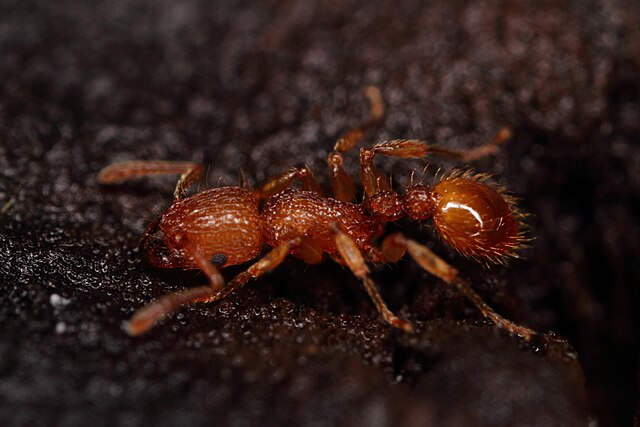
The Bicolored Pennant Ant (Tetramorium bicarinatum) is known for living in tropical climates. It’s also found in Texas where it can sting people when it makes its way inside of the house.
While not a common pest, the species sometimes makes it indoors.
Bicolored Pennant Ants mostly seek insects around the house and garden. They suck the juices out of insects as a preferred protein source.
Identifying these ants is easy based on their small size. They grow only to 4mm both in Texas and in other parts of the world such as Australia.
The ants have a light brown-red body with a dark brown abdomen.
Most Bicolored Pennant Ants are found under dead logs or on dead parts of a tree.
13. Longhorn Crazy Ant

The Longhorn Crazy Ant (Paratrechina longicornis) gets its name from its seemingly erratic moving behavior. Ants of the species move in a zig-zag pattern.
Ants of the species are characterized by a small body size of up to 3mm. They have a brow-black body with a slight blue undertone at times.
Further distinct physical traits include very long antennae and eyes that are located far in the back of the head.
These ants don’t sting but they can bite. They’ve also been categorized as pests as they have been shown to invade homes even high-rise buildings.
Longhorn Crazy Ants are known as some of the most common species in the world.
These ants have a varied diet. They are known for consuming honeydew in spring and fall. These ants often eat insects during the summer.
Preferred insects include aphids and small-scale insects.
14. American Carpenter Ant
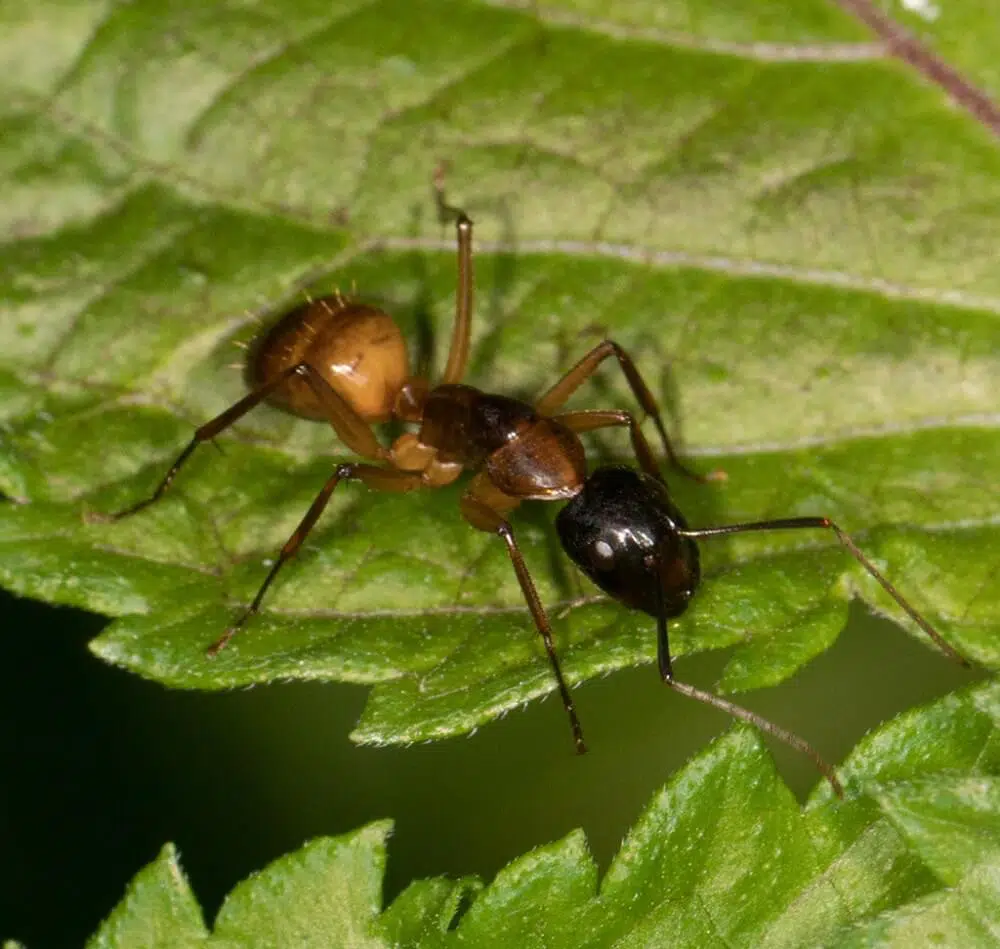
The American Carpenter Ant (Camponotus americanus) is a native species with a widespread presence in the US and across Eastern US states.
It can be identified as a larger ant species as it grows to an adult size between 7 and 10mm.
These ants can be recognized by their brown thorax, and striped red-brown abdomen. The head is dark brown.
American Carpenter Ants live in a wide range of habitats. They have been shown to thrive in wetlands but they are mostly found around oak forests.
These nests typically nest in the ground under dead oak logs. They form nests that extend from the soil to the dead logs.
15. Deceptive Carpenter Ant
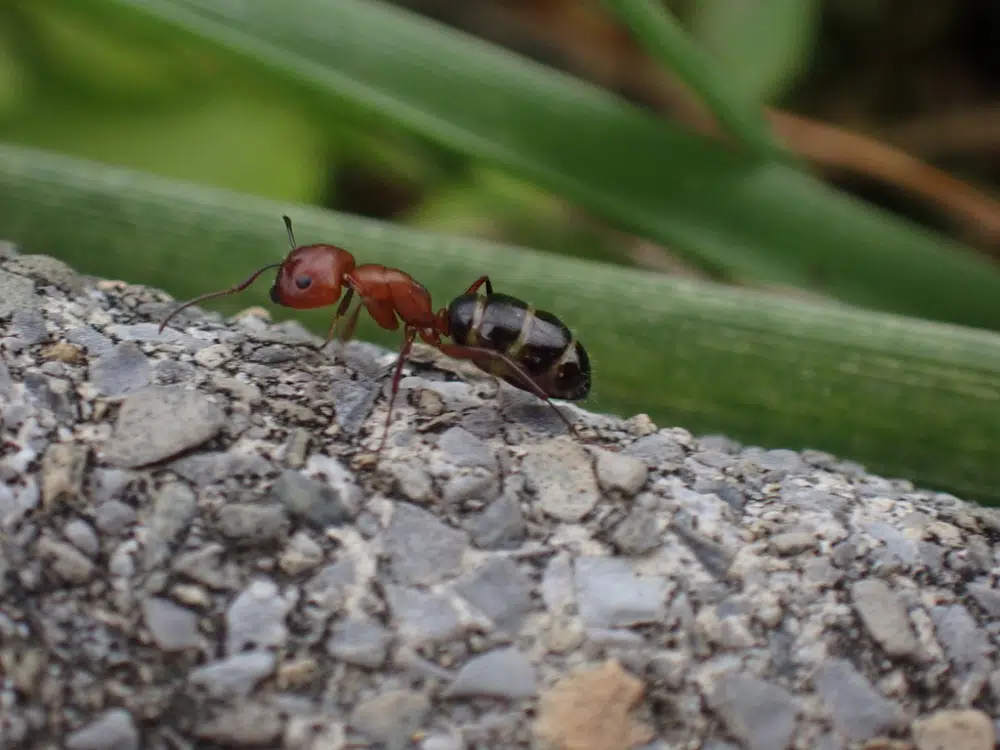
These brown ants (Camponotus decipiens) are known for having dark brown abdomen. Short white hairs are also seen on the abdomen.
Deceptive Carpenter Ants grow to a size between 3.5 and 7mm.
Preferred nesting locations include damp soil such as under logs. However, these ants are also pests as they can nest inside walls.
Most nests built by Deceptive Carpenter Ants are small. Numbering up to 100 individuals, these nests are led by a queen ant.
16. Yellow Pyramid Ant
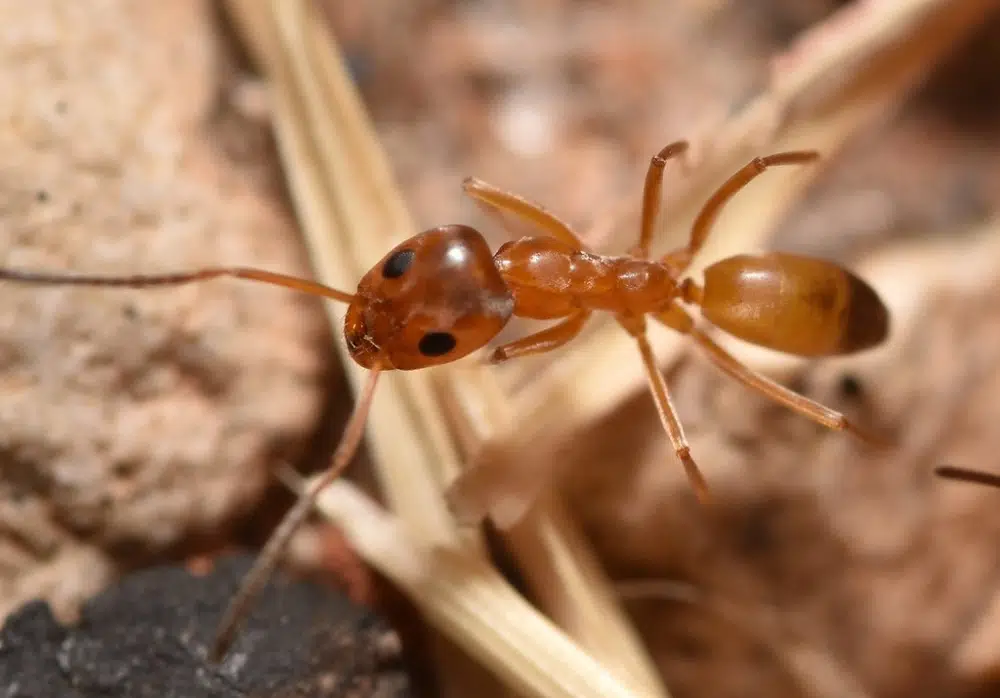
The Yellow Pyramid Ant (Dorymyrmex flavus) is present in high numbers across Texas and all Southern states as well as parts of Mexico.
It gets its name from its mostly yellow color. These ants have a translucent yellow color head, thorax, abdomen, antennae, and legs.
Small color variations are also possible. The yellow color can be closer to red in some colonies or closer to amber in other colonies.
These ants are also known to have many predators and to be the favorite prey for the Moustached Tiger beetle (Ellipsoptera hirtilabris).
17. Compact Carpenter Ant

Compact Carpenter Ants (Camponotus planatus) are often confused with termites as they can be found in old termite nests at times.
These ants are pests and they are found indoors and inside walls in old wood galleries dug by termites.
Compact Carpenter Ants mostly make it indoors by crawling through wall cracks and under doors.
Diet preferences include honeydew which is collected during the day.
Compact Carpenter Ants are part of a group of diurnal carpenter ants.
18. Camponotus sansabeanus
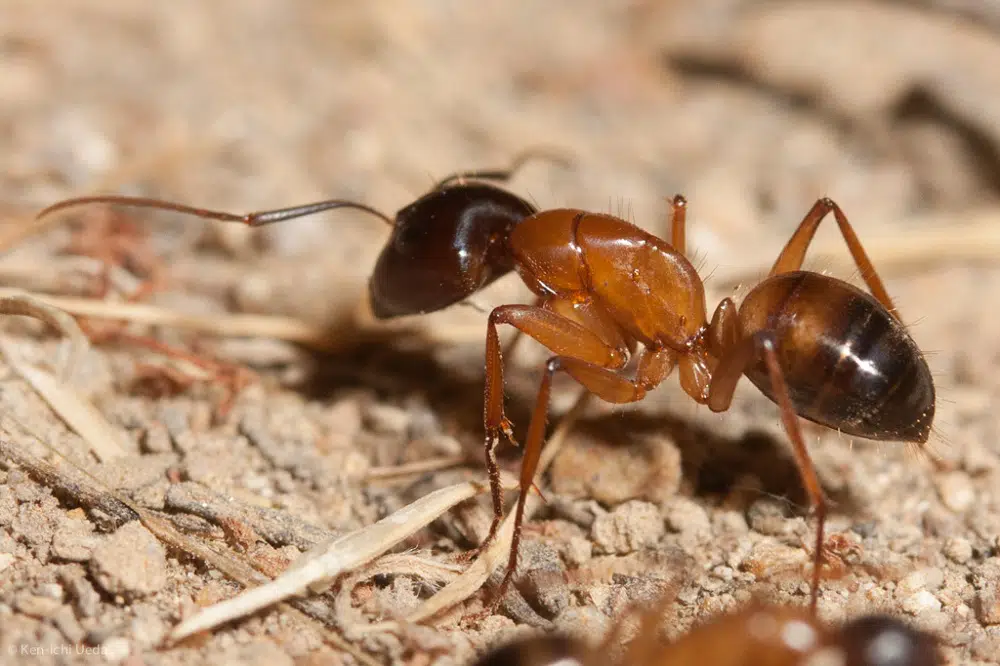
These ants are common in the desert regions of Texas and neighboring states. It’s a species that comes in many colors from brown to black.
Most ants aren’t common to humans as they’re nocturnal and because they don’t live in human-populated areas.
However, they are known foragers that can sometimes be found nesting under pieces of wood or under rocks.
19. Pallid Twig Ant
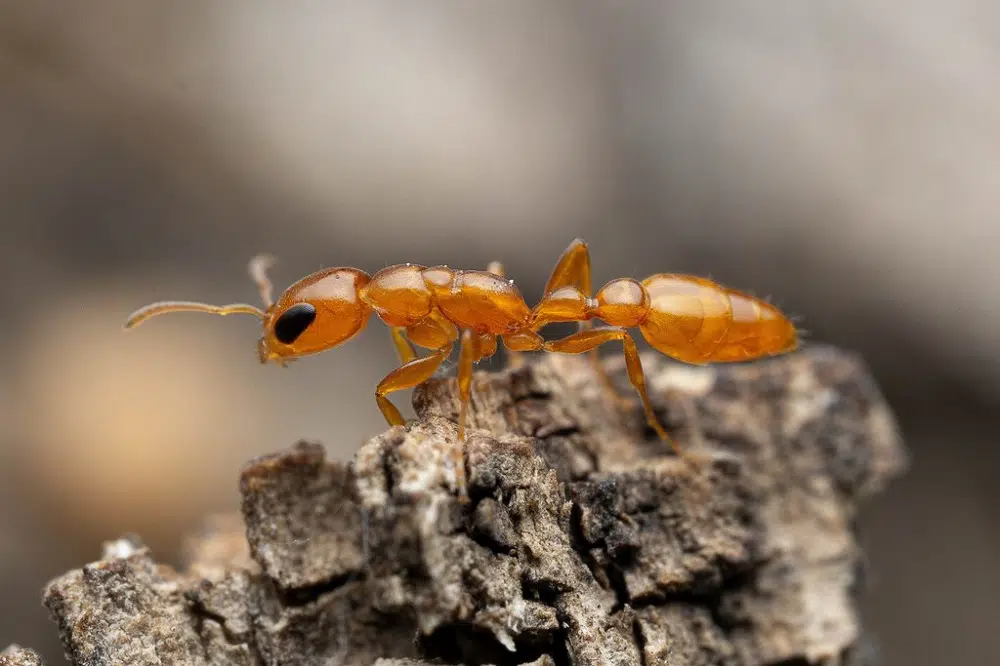
The Pallid Twig Ant (Pseudomyrmex pallidus) is brown, orange, or yellow. These ants have a single color and a shiny body without hairs.
Many ants of the species are winged losing wings after mating. Signs of previous wings are seen as scars on the thorax, particularly for queens that have already mated.
Queen Patllid Twig Ants lead nests of small sizes of up to 200 individuals. Large nests tend to separate into multiple smaller nests instead of becoming overcrowded.
These ants don’t store food for later consumption. They are known for eating plant nectar away from the nest. Pallid Twig Ants also consume insects.
20. Chestnut Carpenter Ant

The Chestnut Carpenter Ant (Camponotus castaneus) is seen in areas of Texas. Its widest distribution is in Southeast US but it’s seen across Texas as a native species.
Chestnut Carpenter Ants are both diurnal and nocturnal, with a preference for night-time activity.
It’s identified by a light brown coloring which can also be dark brown in other regions of the country.
These ants grow above the average size of Texas ants to a size between 7 and 10mm.
21. Novomessor cockerelli
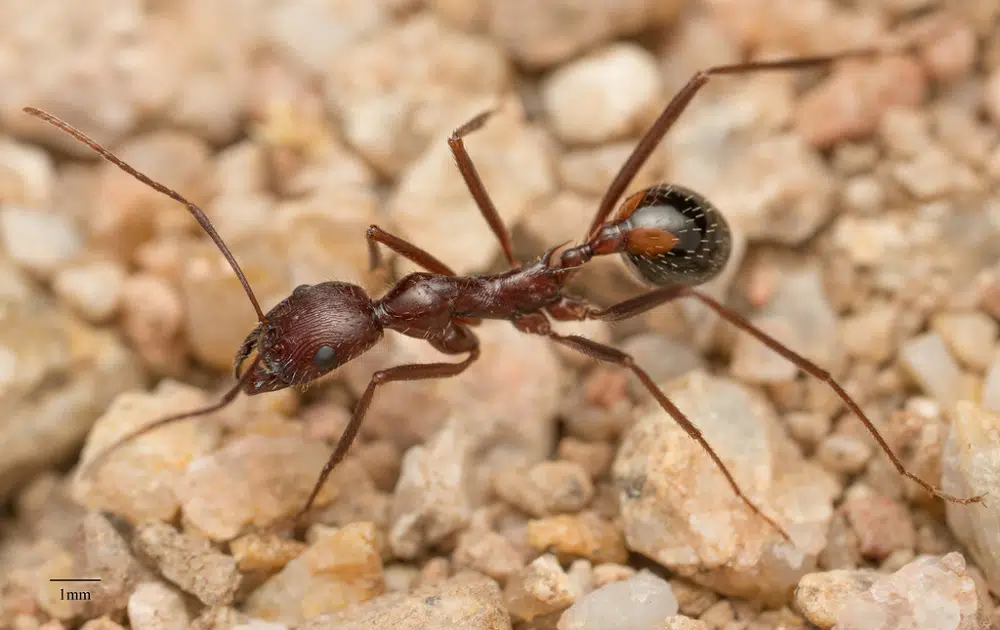
Ants of this species are very common in Southern US deserts. They have a common black body color with a dark brown to black gaster.
These ants make very large underground nests that have multiple entrances. Most entrances are shielded by pebble, mulch, logs, or rocks.
Ants of the species are known, foragers. They consume seeds that provide fat, protein, and water.
They also consume insects for higher protein content. Dead animals are also part of the diet of these ants.
Some Novomessor cockerelli ants are misinterpreted for only consuming dead animals but they’re also seeking insects to feed on which are attracted to dead animals.
22. Comanche Harvester Ant
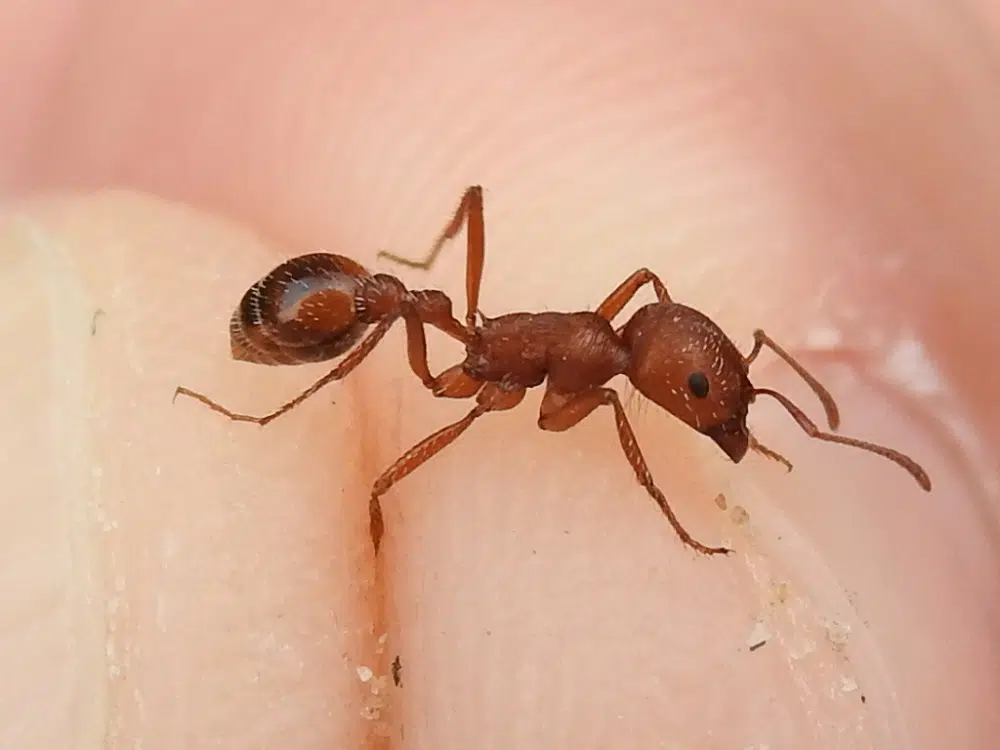
The Comanche Harvester Ant (Pogonomyrmex comanche) is a Texas native.
It nests in sandy soils which are easy to dig through. These ants have rarely been seen nesting in other types of soil.
Comanche Harvester Ants are known for their interest in seeds. They collect seeds that are deposited in the nest.
Known for an amber-brown color and small round eyes, these ants are easiest to identify when you find a nest in sandy soil outside urban and suburban areas.
Comanche Harvester Ants aren’t seen as a pest as they don’t live in human-populated areas.
However, it’s best to avoid handling these ants as they have a very painful sting.
23. Elongate Razorjaw Ant
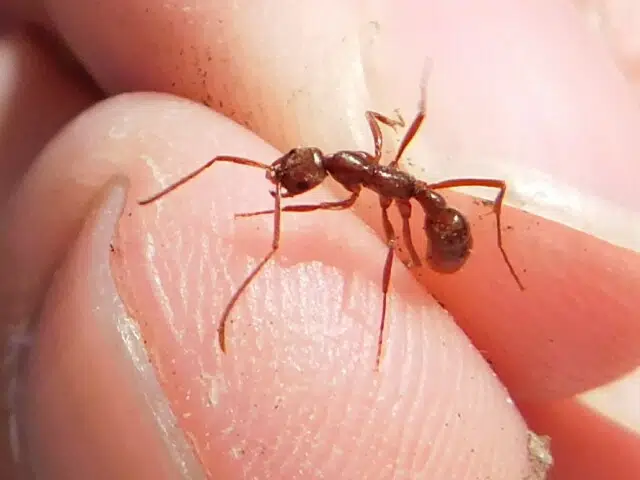
These ants (Leptogenys elongata) are known for their long amber-brown bodies with long antennae.
While not a serious home pest, Elongate Razorjaw ants are known to be constantly seeking moist environments for bugs and food sources.
The preferred diet of the species is terrestrial isopods.
24. Argentine Ant

Native to regions of South America such as the Northern parts of Argentina, this species (Linepithema humile) is one of the household ant pests in Texas.
Ants of the species make their way into homes during periods of heavy rain when they try to escape the flooding of their outdoor nests.
They make their way into homes easy given these are some of the smallest ants in Texas.
Argentine Ants typically measure at least 1.6mm and up 2.8mm.
However, these ants can crawl through smaller 1mm openings which means they can get inside almost any house under doors or around window frames.
Pesticides have a reduced effect on these ants when dealt with as a pest. In fact, some pesticides can even prompt queens to start laying more eggs.
It’s never advisable to step on Argentine Ants to destroy them as they’re often led by multiple queens in a home invasion.
Killing a queen is not a good pest-control measure. Instead, it’s recommended to use insecticides such as fipronil that Argentine Ants carry to their nests eventually killing all members inside.
Further Reading: